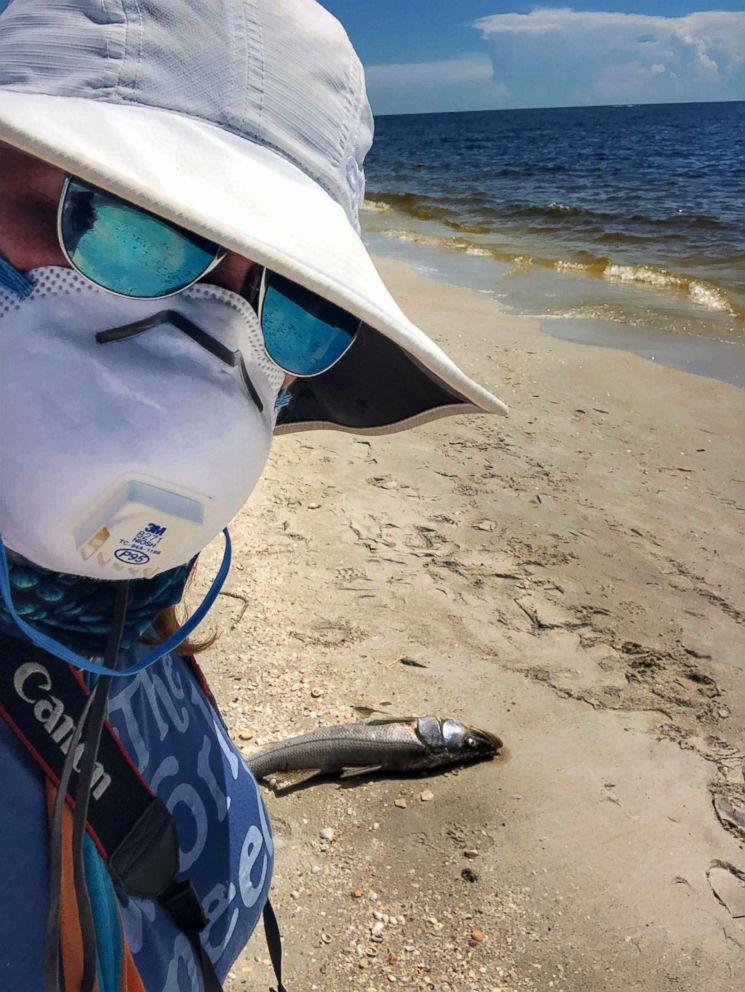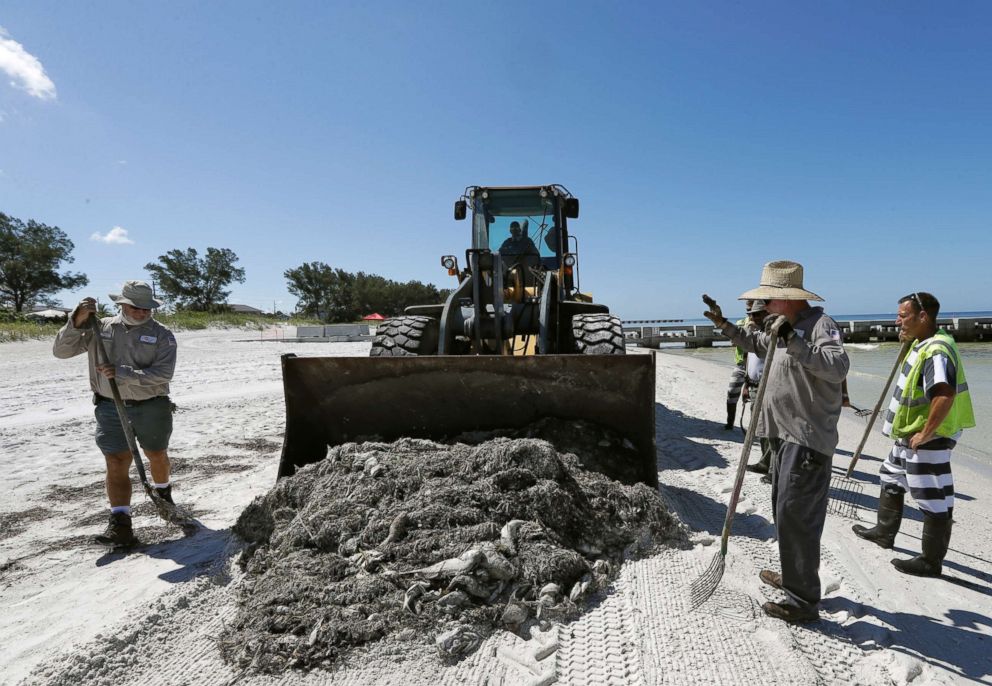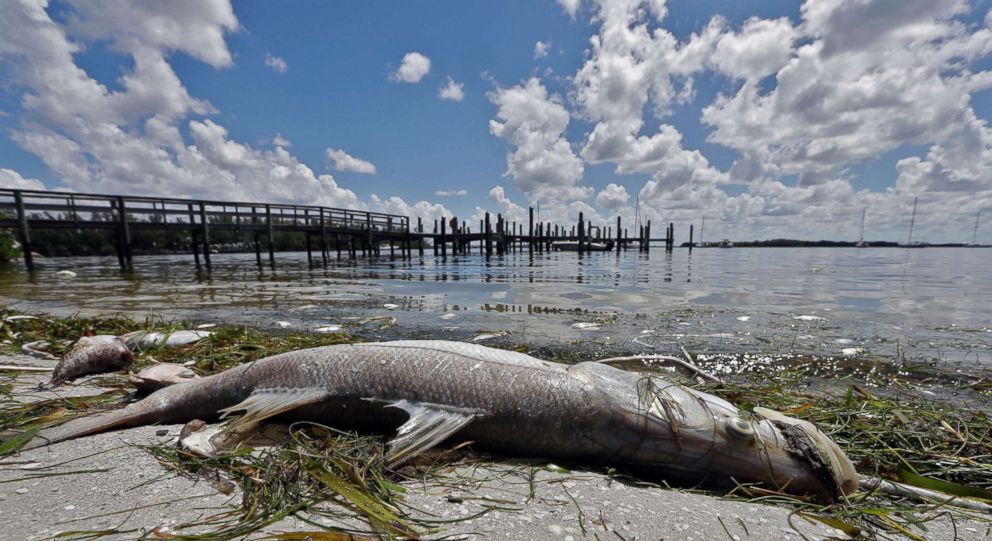'When is this going to stop?': Florida activist highlights devastating impact of algae blooms on wildlife
Red tide is natural but the current event has lasted more than a year.
Colleen Gill walks the beaches in Naples, Florida regularly, a scarf or mask covering her mouth and armed with a camera and cell phone.
For months Gill has been documenting the effects of the red tide, specifically dozens and dozens of dead fish, eel and dolphins that have washed up on the beach.
"The entire food chain is impacted now. We've had six months of consecutive fish dying," Gill said.
Gill said she decided to start showing people what was happening on the beach after she attended a demonstration of activists holding hands on the beach to bring attention to issues impacting the ocean.
"We had a big giant eel wash up behind us that day," she told ABC News.
Gill has lived in Naples for years and vacationed there regularly for 20 years before that. She's watched for years as algae blooms plagued the coast, but between human contributions and climate change the issue seems to have gotten worse, she said.
"The canary in the coal mine has literally died," she said.

Harmful algae blooms known as red tide occur naturally but scientists say it could be aggravated by warm water temperatures and more acidic oceans attributed to climate change. Residents say this one, which has lasted almost 14 months, is unusual and has killed more animals than it normally would.
While Gill attributes the severity of this year's red tide to the changing climate, local Republicans aren't convinced of the connection.
Florida Gov. Rick Scott, now a senator-elect, declared a state of emergency earlier this year and allocated millions of dollars for cleanup and response. But critics say his support for loosening environmental regulations are part of why the algae blooms have been so bad over the last year and cost the state millions of dollars in tourism revenue.
Members of Florida's congressional delegation on both sides of the aisle have also pushed for more federal money to study red tide and health threats from harmful algae blooms.
Scott has also blamed Democrats in Washington, saying they haven't pushed for better federal management of the areas around Lake Okeechobee.
Activists disagree and say the state should focus on solutions to protect Florida's environment.
"It’s horrendous, there’s dead fish everywhere, the seagrass is dead. You’re witnessing full ecological collapse from the very bottom of the food chain all the way to the top," Daniel Andrews, executive director of the advocacy group Captains for Clean Water, told ABC News in an August interview. "Although red tide is natural, it’s not natural for it to be this severe.”

The red tide chokes the ocean's oxygen levels and releases a toxin that can poison fish. It's been going on so long that the effects are now suspected of killing animals like dolphins and birds that ate contaminated fish.
The National Oceanic and Atmospheric Administration says 123 dolphins have stranded as a result of the red tide since November 2017 and the red tide is suspected of contributing to the deaths of more than 200 manatees that swam in the bloom area or ate seagrass that contained the toxin.
Gill has posted videos of dolphins that she encounters during her patrols on the beach, even sometimes showing her emotional response. In one video posted earlier this month, Gill said she found seven beached dolphins in 24 hours.
"When is this going to stop?" Gill tearfully asks in the video. "We are killing our paradise and our beaches, people."
Florida resident Colleen Gill posts video of beached dolphin on Facebook
As Gill and other advocates bring attention to the algae bloom's impact on wildlife, they're concerned this year's event is a sign of what's to come and that as climate change causes warmer temperatures and more severe rain there could be more dangerous algae blooms that continue to persist in the future.
Gill said Florida is the epicenter of climate change in America but that the state government doesn't acknowledge the issue. Gov. Rick Scott has been accused of banning the use of the phrase "climate change" in his administration.
"Literally the day I was crying over a dolphin last week was the day Trump was coming out saying, 'I don't believe it,'" Gill said of the recently released national climate report.
But the red tide is only one of two ecological disasters impacting Florida waters, both of which activists say are made worse by a lack of regulation from the state and warming waters attributed to climate change.
While the red tide threatens animals that rely on the ocean off Florida's coast, a mucky blue/green algae resembling pea soup has invaded Florida's freshwater from Lake Okeechobee to canals in part of the state.
The red tide is made worse by excess nutrients in the water and warmer water temperatures but it does occur naturally almost every year, typically starting in the Gulf of Mexico and moving toward shore under certain weather conditions.
The blue/green algae bloom, however, is more directly connected to nutrients in fertilizer like nitrogen and phosphorous. When it rains or water flows over the soil where the nutrients weren't absorbed it can facilitate the growth of blue/green algae, also called cyanobacteria.
Both algae blooms are harmful to the environment and release toxins that can pose a threat to human health.
The cyanobacteria that make up the bloom release a toxin that can be harmful and even fatal for people or animals that ingest it. Exposure to the toxin has also been linked to degenerative diseases like ALS.

Red tide toxins aren't deadly and the state says swimming in affected water is generally safe, but the toxin can cause skin irritation or breathing problems, especially for people with asthma or COPD. The toxins can also accumulate in fish or shellfish that can be poisonous to people who eat contaminated seafood.
Activists and residents say the state hasn't done enough to combat the harm from the algae blooms, and that policy rollbacks from Republican politicians have made the situation worse. They say that nutrients in the water from untreated sewage and fertilizer runoff has fed the algae and made them worse than it would be if the state had stricter rules about releasing pollution that could flow into rivers and lakes.
Rae Ann Wessel, natural resource policy director for the Sanibel-Captiva Conservation Association, said those nutrients are why the state needs rules on how stormwater is treated and how fertilizer can be used to limit how much of those nutrients are released into the state's water and limit the fuel for these algae blooms.
"The fix ultimately is that we have to control nutrients at their source, and there's a whole variety of sources. The good news is we know what those sources are, we have solutions and fixes for these sources, what we need is the political will, funding, commitment, and leadership. And that's a pretty big ball of wax," she told ABC News.

But even though some cities have tried to update regulations that patchwork of rules and lacking enforcement make it difficult to find one solution to the problem. And as climate change leads to longer rain events and more severe storms cities will have to adapt to how to handle all that water.
"These aren't federal issues, these are state issues that they rolled back or stopped enforcing with the idea that its good for business to have less regulation," said Rae Ann Wessel, natural resource policy director for the Sanibel-Captiva Conservation Association.
"You can ask any of the chambers [of commerce] that I'm working with and this is not good for business, and there's no end in sight, and its scary."
ABC News' Lissette Rodriguez contributed to this report.




